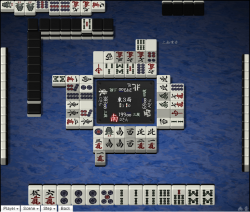Tanki
| Kanji | 単騎 |
|---|---|
| English | Pair wait |
| Fu | 2 fu |
| Tile types waiting | 1 sided wait |
| Tiles available | 3 tiles |
| Pattern example |
|
| Tenhou.net example |
Tanki 「単騎」 is a common type of wait pattern. Most mahjong hands form to complete the fourth meld. However, a handful of mahjong hands can be formed with four complete groups, while needing to finish the pair. That makes this pattern referred to as the "pair wait". Unlike the other basic patterns, there are a few types of pair waits to consider.
Pattern
The wait pattern involves waiting for a single tile. In doing so, the hand is looking to complete the pair, while the rest of the hand is completed.
Hadaka tanki

Hadaka tanki 「裸単騎」 is a special type of pair wait pattern. A hand in this state has called for discarded tiles four times. Upon doing so, only one tile is left closed in the hand. The yakuman suukantsu always ends up as hadaka tanki at tenpai.
Of all the hand possibilities, hadaka tanki is the weakest position in terms of defending. Only one tile can be exchanged by the draw-discard process. This is due to the static nature of tiles in open calls. The worst case scenario for a hand in hadaka tanki involves both the waiting tile and the drawn tile as winning tiles for another player. In this case, a player has no choice but to play into another player's hand.
Jigoku
Jigoku 「地獄」 is a specific tanki wait, where two tiles are rendered unavailable within the discards and/or the dora indicator. This is not applicable when additional tiles are held within players' hands, because their whereabouts are unknown to the waiting player.
Nakabukure
Nakabukure 「中膨れ」 is a type of pair wait. Here, the middle tile is duplicated in a sequence. So, the waiting tile is that single duplicated tile. With two of the tiles of that type in hand, this gives the wait one less tile to wait for compared to a regular tanki. An alternate term, harabote 「腹ボテ」, may be used, but it is also an inappropriate term.
Multiple
Normally, the tanki wait is on a single tile. However, it is possible for a hand to have multiple tanki waits, aligned with suji. The two patterns, Nobetan and Sanmen nobetan, are extended tanki waits. This is possible because they are appended to a sequential pattern. Yet, the hand is still needing a pair to complete.
Chiitoitsu
Every chiitoitsu tenpai hand uses tanki, as the pattern looks to match up the last pair for completion.
Value
By default, the tanki wait counts for 2 fu. If the pair happens to be counted as "yakuhai tiles", then an additional 2 fu is applied. If the hand wins by self-draw (tsumo), then the hand gets an additional 2 fu for that.
Strategy

Tanki, or single tile, is best used when seeking to win off of a player's discard. Under any circumstance, the wait pattern waits for at maximum three remaining tiles of the same tile type. Under any means, it is never waiting for another tile type. It's greatest strength stems from its ability to select any tile as a waiting tile, barring any tile limitations applied by certain yaku. This pattern may confuse players; and even traps, like suji traps, may be employed. Not even kabe may be applicable. Waits involving honor tiles, especially when one is discarded, is actually powerful, because players may believe those tiles are actually safe tiles. This is especially true with hands involving jigoku, or hell waits. All-in-all, this pattern is best used to counter or bait players, who are looking to defend.
External links
| ||||||||||||||||||||||
